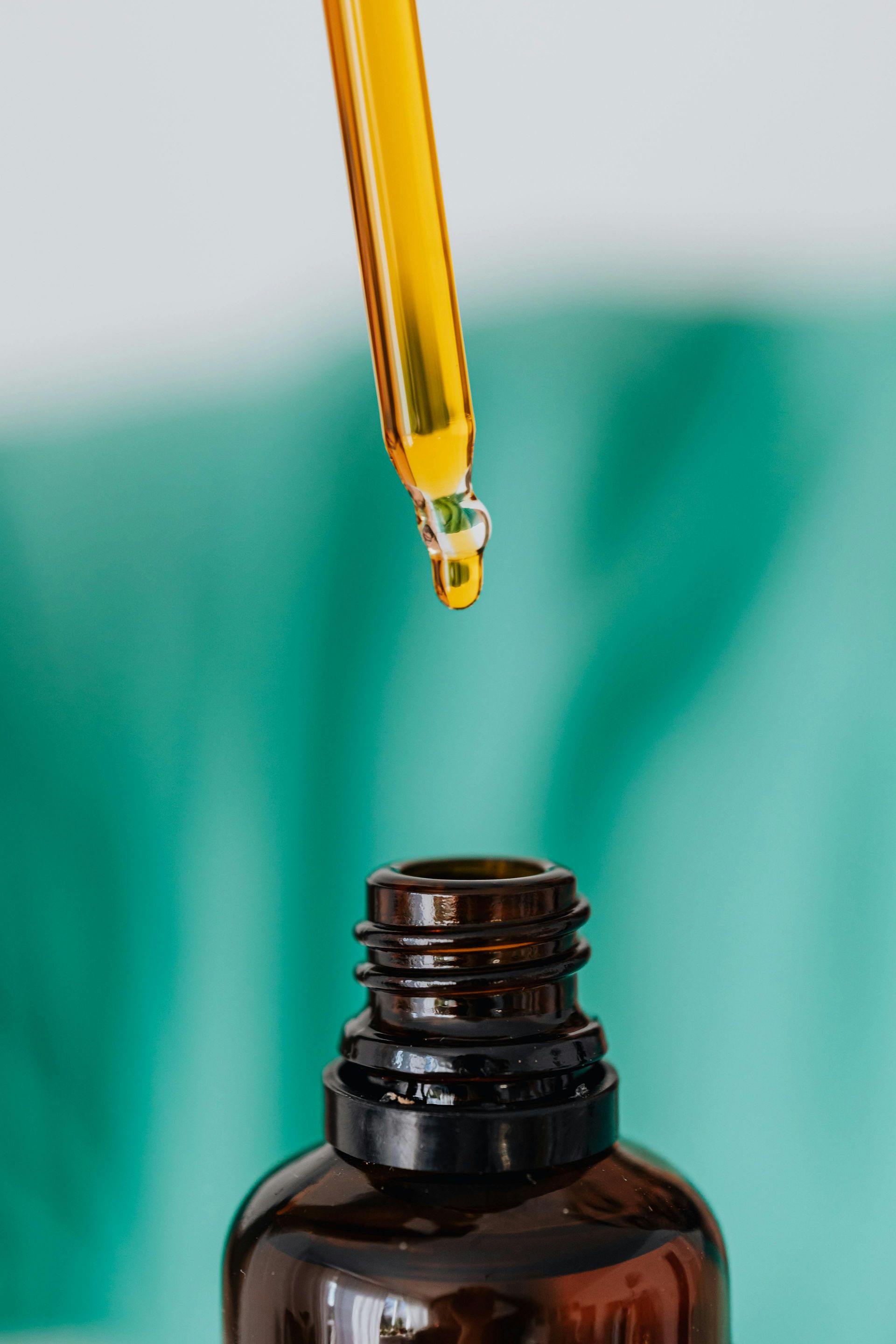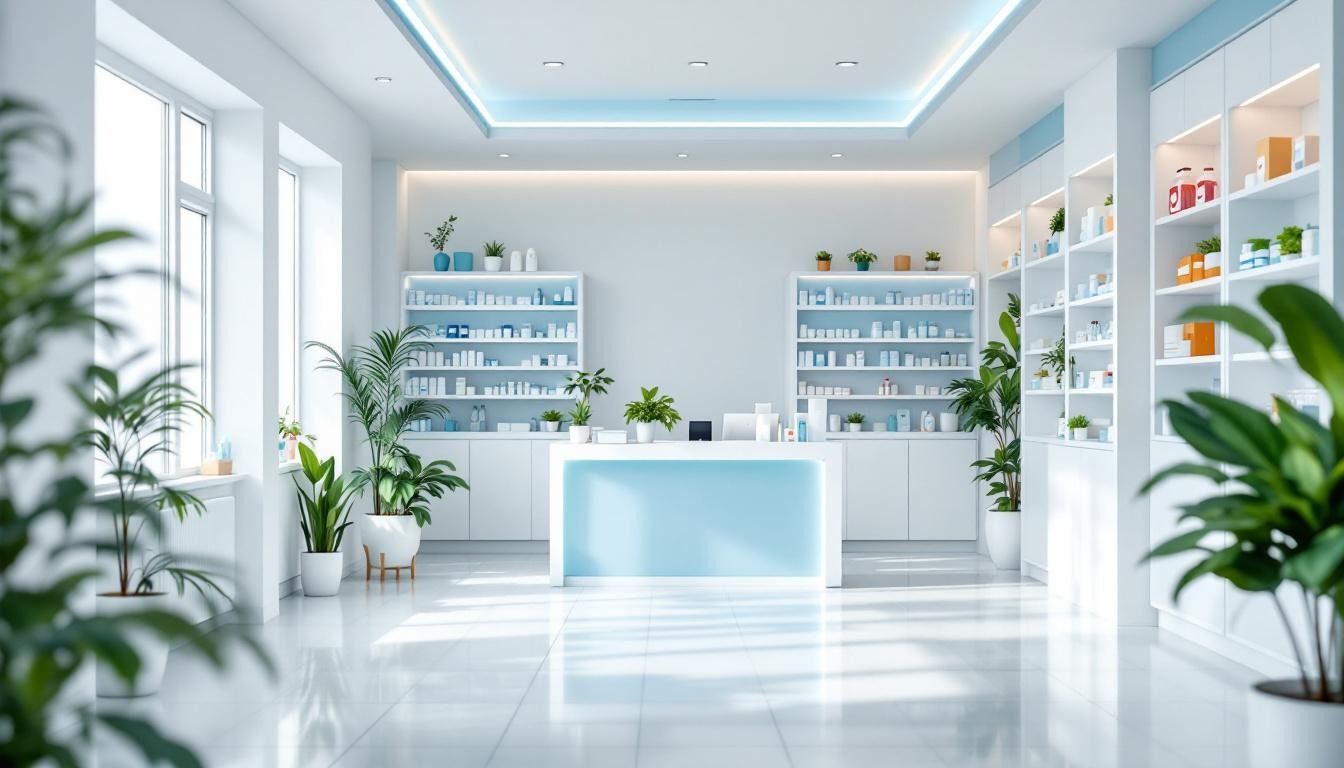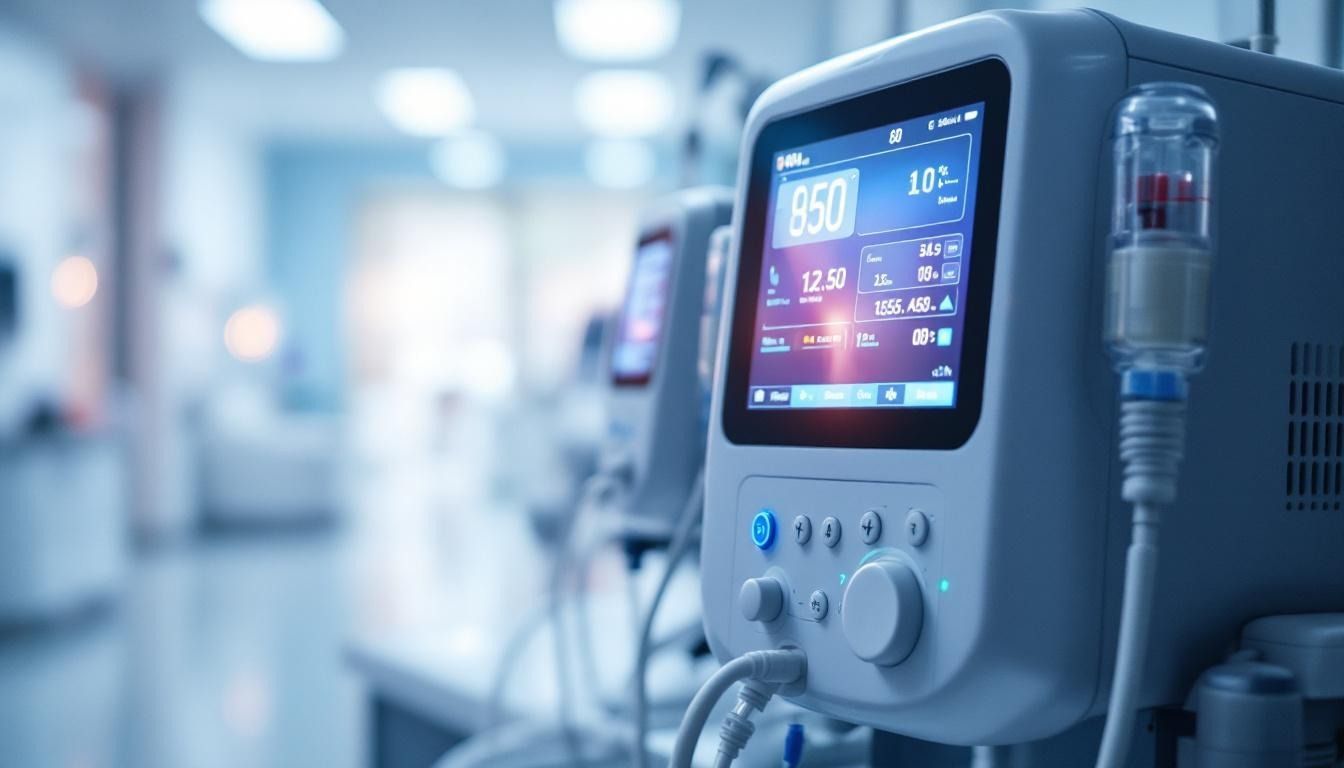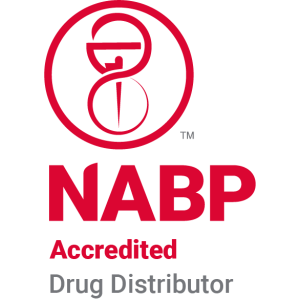Sterile compound infusion options
Understanding the Foundations of Sterile Compound Infusion
Sterile compound infusions are critical components of modern healthcare, enabling personalized treatments for numerous conditions. Ensuring the safety and efficacy of these preparations involves strict adherence to regulatory standards, environmental controls, and best practices. This article explores the various options for sterile compound infusions, the regulatory landscape that guides their preparation, and the methods used to minimize risks and optimize patient outcomes.
Overview of Sterile Compound Infusion Options and Methods
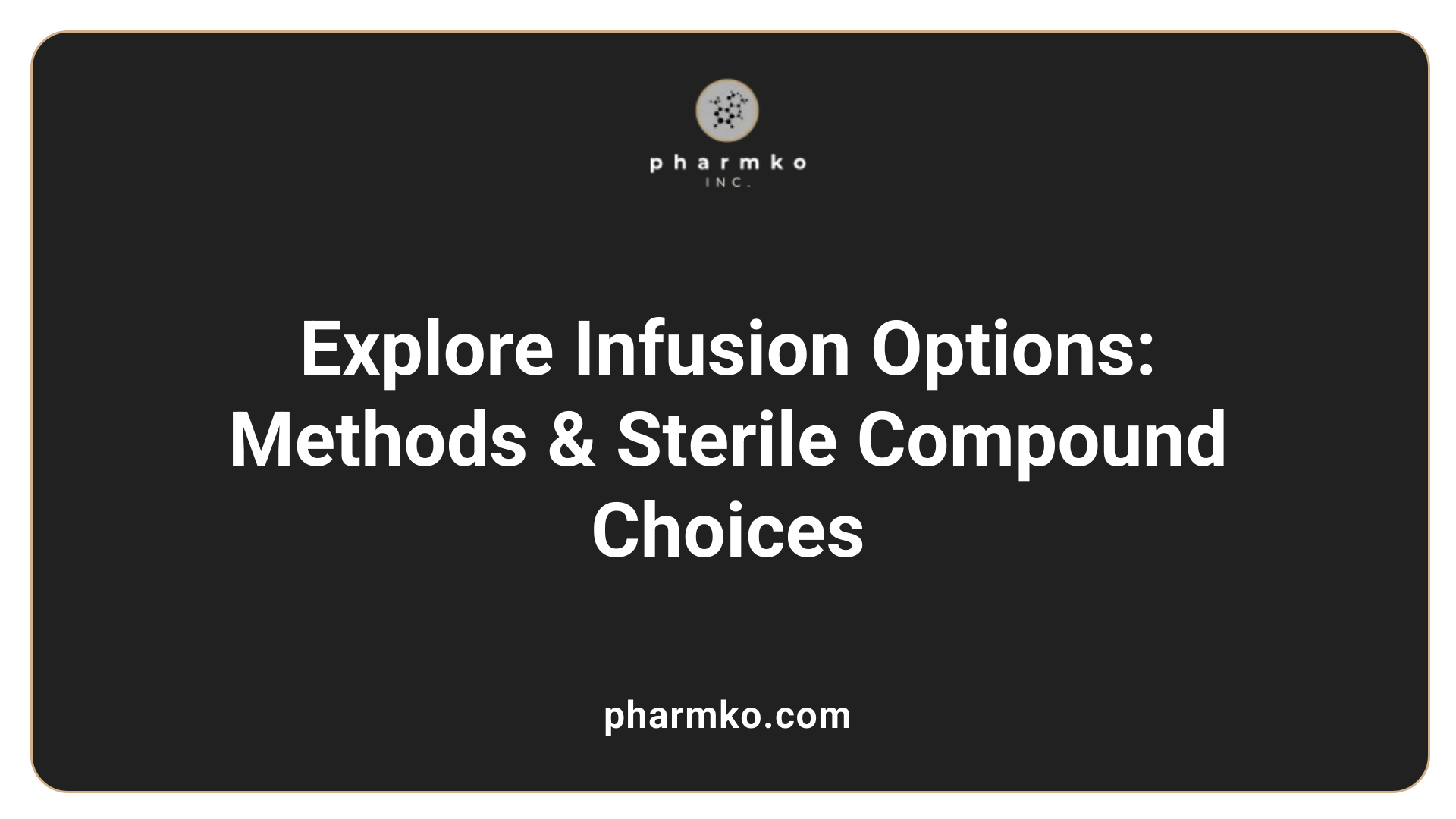
What is USP 797 and how does it relate to sterile compounding?
USP <797> is a set of standards published by the United States Pharmacopeia that governs the practice of sterile compounding. Its goal is to ensure that compounded sterile preparations (CSPs) are safe, effective, and free from contamination.
This chapter provides detailed guidelines on aseptic techniques, environmental controls, personnel training, and quality assurance processes. It specifies requirements for different categories of CSPs, including how and where they should be prepared, with particular attention to environmental conditions such as ISO classifications.
USP <797> emphasizes the importance of maintaining strict cleanroom environments, proper sterilization, and accurate documentation. It also guides beyond-use dating (BUDs), which helps determine how long a sterile product remains safe for patient use.
Officially revised and published on November 1, 2022, with an implementation date of November 1, 2023, the standards reflect the latest advances in science and best practices in sterile compounding. Overall, USP <797> is central to standardizing and improving the safety of sterile medications in healthcare.
Regulatory Standards and Environmental Controls in Sterile Compounding
What do the USP standards and revisions mean for sterile compounding?
USP (United States Pharmacopeia) sets the foundational standards for sterile compounding to ensure medication safety and effectiveness. The latest update to USP General Chapter <797>, published on November 1, 2022, and now in effect since November 1, 2023, provides comprehensive guidelines for preparing, verifying, and storing sterile preparations. These standards are based on scientific data, expert opinion, and regulatory requirements, aiming to harmonize practices nationwide.
The chapters include revisions to beyond-use dates (BUDs), risk classifications, and environmental controls that influence how pharmacies and healthcare facilities uphold high standards of cleanliness and safety. USP standards guide not only domestic pharmacies but also align with global best practices to minimize contamination risks and protect patient health.
How are facilities designed to meet strict environmental standards?
Sterile compounding requires specialized facilities that meet stringent environmental specifications, primarily defined by ISO (International Organization for Standardization) classifications. Critical areas where sterile preparations are made must be ISO Class 5 environments, maintained through advanced HEPA (High-Efficiency Particulate Air) filtration systems. These include laminar airflow workbenches, biological safety cabinets, and isolators.
Buffer areas typically maintain ISO Class 7 air quality, serving as buffer zones to prevent contamination of primary engineering controls. Ante areas are designated for staff preparation and decontamination, constructed to prevent the introduction of microbes into the clean zones.
What are the roles of air quality controls and filtration systems?
Air quality and filtration are vital in preventing microbial contamination in sterile environments. These facilities employ HEPA filters in ventilation systems to trap airborne particles and microbes, creating a sterile, controlled environment. The airflow must be designed to minimize turbulence and prevent cross-contamination, often through laminar flow systems that provide unidirectional airflow.
How is cleaning, disinfecting, and environmental monitoring handled?
Routine cleaning and disinfecting are essential daily procedures, using agents recommended specifically for sterile environments. Surfaces and equipment are cleaned frequently to eliminate microbial presence.
Environmental monitoring encompasses both viable and non-viable particle testing. Regular testing ensures that air quality remains within acceptable limits. Temperature and humidity are continuously monitored and recorded. Surface sampling and pressure differentials help verify that environmental conditions stay consistent with ISO standards.
Implementing rigorous cleaning schedules, environmental testing, and maintaining proper airflow and filtration systems are fundamental to ensuring the sterile environment required for safe CSP preparation.
| Aspect | Standards & Practices | Details |
|---|---|---|
| USP adherence | Updated guidelines post-2022 | Ensures compliance with latest compounding practices; includes risk-based BUDs and environmental controls |
| Facility design | ISO Class 5 in critical zones | Requires HEPA filtration, laminar airflow, dedicated buffer and ante areas |
| Air quality | HEPA filtration & airflow control | Maintains ISO Class 5 environments; prevents contamination |
| Cleaning & monitoring | Routine procedures | Disinfectants, surface sampling, viable/non-viable particle counts, temperature, and humidity control |
Through adherence to these detailed standards, sterile compounding facilities safeguard patient health by minimizing microbial growth and contamination risks.
Personnel Training, Certification, and Aseptic Technique
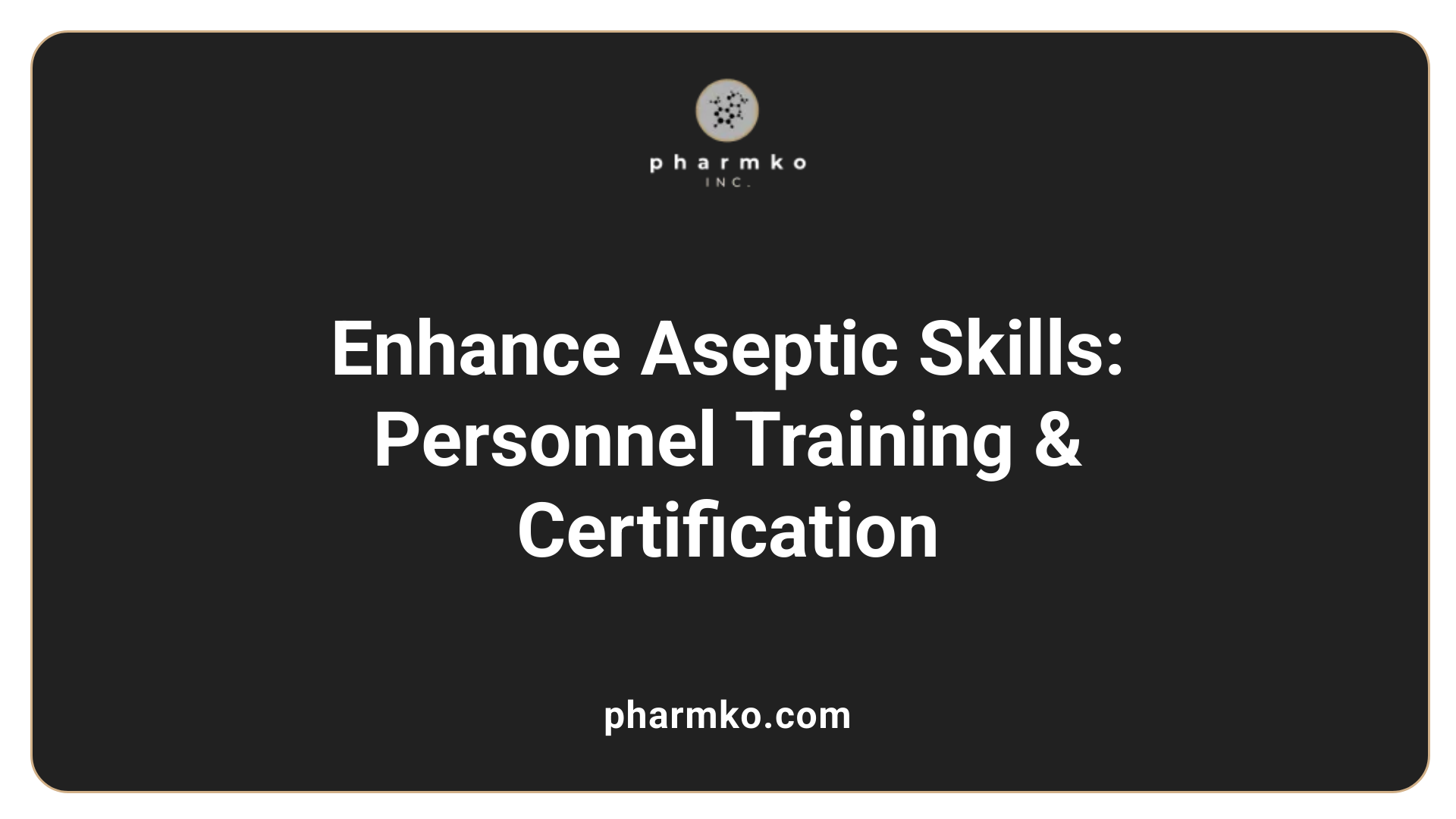
What are common IV fluids used in preparing sterile pharmacy products?
In sterile pharmacy preparations, several IV fluids are commonly used as vehicles to deliver medications or to hydrate patients. These fluids must be prepared in environments that meet strict sterility standards to prevent contamination.
Normal saline (0.9% sodium chloride) is the most frequently used IV fluid for preparing sterile products. It is ideal for hydration, dilution, and as a solvent for various medications. Half-normal saline (0.45% sodium chloride) is used when a hypotonic solution is needed, especially in cases of sodium deficiency or specific electrolyte imbalances.
Lactated Ringer's solution is another popular choice, containing electrolytes like sodium, potassium, calcium, and lactate to closely resemble the body's plasma composition. It is often used in surgeries and trauma cases.
Dextrose solutions, such as 5% Dextrose in normal saline (D5NS), serve as both energy sources and solvent vehicles for medication administration. Colloid solutions like albumin are utilized in specific clinical scenarios to expand blood volume, although they are less common exclusively for sterile medication preparations.
The choice of IV fluids depends on the patient's condition, the specific medication stability considerations, and compatibility requirements. Ensuring these fluids are sterile, properly stored, and prepared in controlled environments is crucial for patient safety.
Sterile Preparation and Quality Assurance

What are common IV fluids used in preparing sterile pharmacy products?
In preparing sterile pharmacy products, especially those administered via injection or infusion, selecting appropriate IV fluids is crucial. Commonly used fluids include crystalloids like normal saline (0.9% sodium chloride), which is versatile for hydration, drug dilution, and as a solvent. Normal saline is the most widely used IV fluid due to its compatibility with a broad range of medications.
Another essential fluid is half-normal saline (0.45% sodium chloride), employed in cases requiring hypotonic solutions, for example, in cellular hydration. Lactated Ringer's solution is also frequently used; it contains electrolytes similar to plasma, making it suitable for replacing electrolytes and maintaining acid-base balance.
Dextrose solutions, such as 5% dextrose in normal saline (D5NS), serve dual roles as energy sources and as diluents for medications. These fluids are sterile and prepared under strict aseptic conditions to prevent contamination.
While colloid solutions like albumin are part of certain treatment protocols for volume expansion, they are less common in the context of pharmacy compounding but may be involved in specialized sterile preparations.
The choice among these IV fluids depends on the clinical scenario, patient needs, compatibility with medications, and ensuring the formulation remains sterile and stable.
Formulation and stability considerations
Formulating sterile preparations requires thoughtful consideration of both the chemical stability of the drugs and the physical stability of the solution.
Stability depends on several factors:
- pH and tonicity of the preparation, which must be compatible with physiological conditions to avoid discomfort or phlebitis.
- Storage temperature and protection from light.
- The presence of preservatives, which may affect sterility or stability.
Pharmacists must verify the stability data and ensure the beyond-use date (BUD) aligns with the findings, especially for compounded products prepared outside of manufacturing settings.
Sterilization techniques and testing for sterility
Sterility is paramount in compounded sterile preparations (CSPs). Common sterilization methods include filtration, especially for heat-sensitive solutions, ultrasonic sterilization, and terminal sterilization of final containers using autoclaving or other heat-based processes.
Post-sterilization, tests such as membrane filtration sterility testing are employed to confirm the absence of microbial contamination. This involves incubating samples in growth media and observing for microbial growth over prescribed periods.
Regular environmental monitoring, including viable and non-viable particle counts, surfaces, and air quality, supports sterility assurance. Equipment used in preparation must be sterilized and maintained according to strict guidelines.
Beyond-use dating (BUD) standards
BUD determines when a compounded sterile preparation should no longer be considered safe for use. It depends on the risk level of the CSP, the environment of preparation, and the storage conditions.
For low-risk CSPs prepared under aseptic conditions, BUDs are often extended, sometimes up to 48 hours at room temperature or longer under refrigeration, provided sterility tests support this extension.
High-risk preparations, which involve prolonged handling or storage, usually have shorter BUDs, often limited to 24 hours or less.
Recent updates to USP <797> emphasize strict adherence to validated BUDs based on stability and sterility data, not extending beyond recommended periods without additional testing.
How does the integrity of sterile preparations impact patient safety?
Maintaining the integrity of sterile preparations ensures that medications are free from microbial contamination, chemical degradation, and physical instability.
Compromised sterile products can lead to infections, adverse drug reactions, or treatment failure.
Strict environmental controls, proper personnel training, validated sterilization processes, and comprehensive documentation all contribute to safeguarding the integrity of CSPs.
| Aspect | Consideration | Details |
|---|---|---|
| Common IV fluids | Crystalloids & Colloids | Normal saline, lactated Ringer's, dextrose solutions, albumin |
| Formulation stability | pH, Temperature, Additives | Ensure drug stability and minimize degradation |
| Sterilization methods | Filtration, Autoclaving, Terminal sterilization | Confirmed through testing and environmental monitoring |
| BUD standards | Risk-based, validated stability | Shorter BUDs for high-risk CSPs, longer for low-risk products |
| Ensuring integrity | Environmental controls, staff training, documentation | Essential to prevent contamination and ensure effective therapy |
Safety and Risk Management in Sterile Infusions
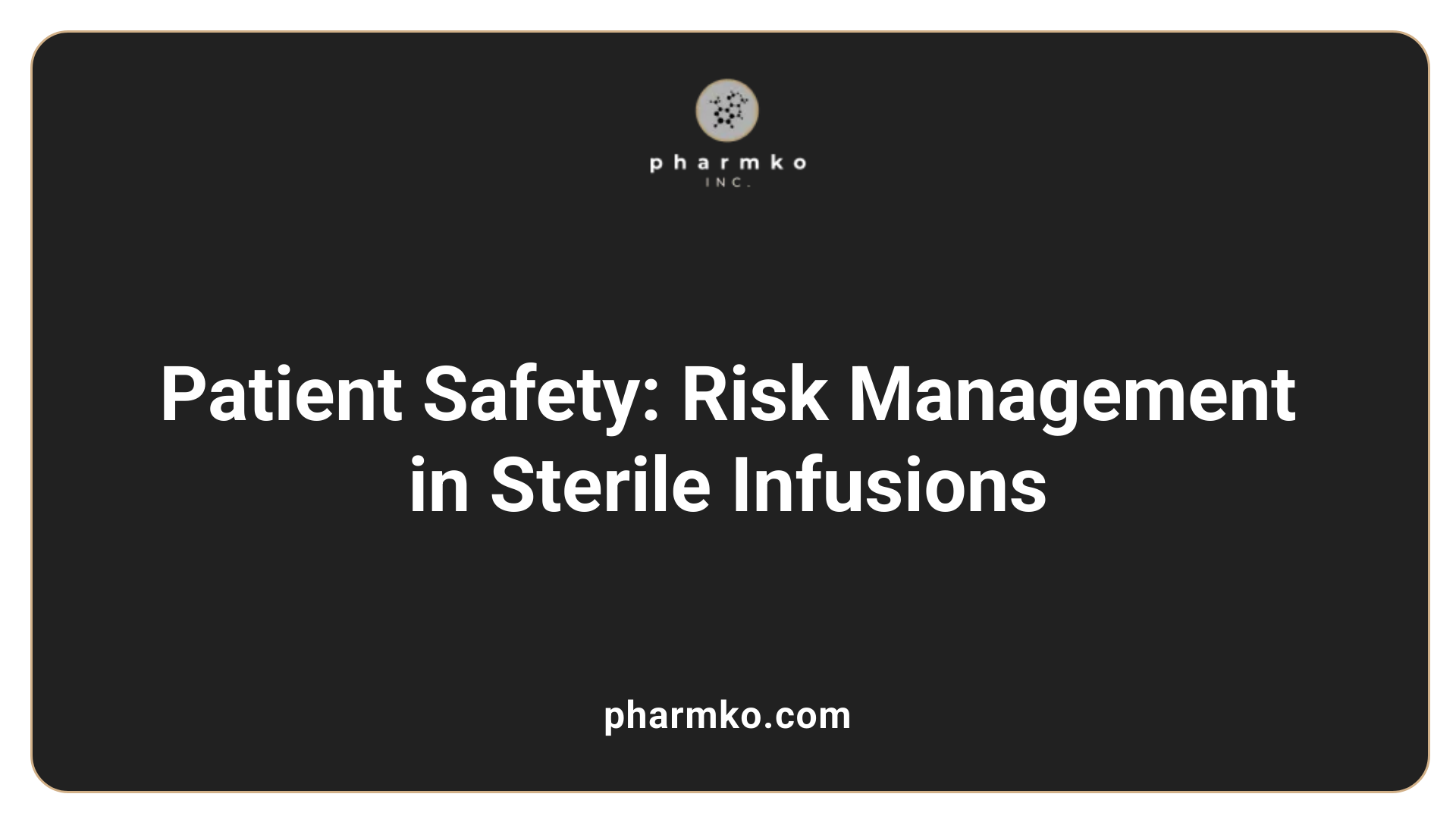
What are common IV fluids used in preparing sterile pharmacy products?
In the preparation of sterile pharmacy products, certain IV fluids are favored for their compatibility, safety, and effectiveness. The most frequently used primary fluids are crystalloids, which serve as both hydration agents and carriers for medications. Normal saline (0.9% sodium chloride) is the standard fluid, widely used due to its isotonic nature that closely resembles blood plasma.
Other common crystalloids include half-normal saline (0.45% sodium chloride), which provides a hypotonic solution suitable for specific medical needs such as cellular hydration. Lactated Ringer's solution is also prominent; it contains electrolytes like sodium, potassium, calcium, and lactate, designed to mimic plasma electrolyte composition.
Dextrose solutions are another vital class, with 5% Dextrose in normal saline (D5NS) being frequently used as energy sources and solvents in pharmacy preparations. These solutions provide nutritional support and facilitate the mixing of medications.
Colloid solutions, such as albumin, are also employed primarily in specialized situations to expand blood volume. While valuable, they are used less frequently when preparing sterile products.
The choice of IV fluid depends on several factors, including the treatment purpose, patient condition, compatibility with other medications, and the need to maintain sterility. Selecting the correct fluid is crucial for patient safety, efficacy of the therapy, and minimizing contamination risks.
Preventing microbial contamination
Ensuring the sterility of IV fluids and compounded preparations is central to avoiding microbial contamination. Facilities must adhere to strict environmental controls, including ISO Class 5 environments for critical sites and ISO Class 7 or better for buffer and ante areas. Proper gowning, disinfection, and equipment sterilization are essential.
Proper handling and disposal
Handling IV fluids and sterile preparations requires aseptic techniques. All personnel must be trained in proper compounding practices, including hand hygiene, garbing, and aseptic technique. After use, contaminated supplies and materials must be safely disposed of according to hospital or pharmacy protocols to prevent environmental contamination.
Use of closed system transfer devices
Closed system transfer devices (CSTDs) are designed to prevent contamination during the transfer of sterile medications and fluids. They are recommended for use during compounding and administration to reduce the risk of microbial ingress or environmental contamination, especially during the handling of hazardous drugs.
Monitoring for contamination and breaches
Routine environmental monitoring, including viable and non-viable particle testing, temperature checks, and surface sampling, helps detect breaches in aseptic conditions. Personnel competency assessments and glove testing also serve as proactive measures to ensure sterile integrity.
By following these practices, sterile infusion preparation can maintain high safety standards, protecting patients from potential infections or complications related to contaminated IV fluids.
Advances in Beyond-Use Dating and Scientific Updates

What is USP 797 and how does it relate to sterile compounding?
USP <797> is a foundational standard established by the United States Pharmacopeia. It sets minimum requirements for the preparation of sterile compounds in healthcare environments, ensuring medications are safe, effective, and free from contamination. This chapter details environmental controls, personnel training, and validation procedures necessary to maintain sterility.
Since its final publication in November 2022, with an official implementation date of November 2023, USP <797> has become a vital reference for pharmacies involved in sterile compounding. It categorizes compounded preparations based on risk levels—low, medium, and high—and outlines specific practices for each category, emphasizing environmental standards, sterility testing, and documentation.
The standard also influences Beyond Use Dates (BUDs), which specify the maximum period a compounded medication may be used safely. By incorporating strict guidelines and scientific evidence, USP <797> helps reduce contamination risks and improve patient outcomes in sterile preparation practices.
Recent revisions to BUD guidelines
Recent updates to BUD policies, published on June 1, 2019, have refined how pharmacies determine the appropriate expiration dates for compounded sterile preparations. These revisions distinguish between nonsterile and sterile formulations, implementing a risk-based approach.
For sterile compounding, the new classification shifts from simple microbial contamination risk levels to categories labeled as Category 1 and Category 2, based on the environment and procedures used. Category 1 CSPs, prepared under less controlled conditions, have shorter BUDs, while Category 2 CSPs, made in more controlled environments, can have longer BUDs.
Furthermore, specific formulations like fixed oil suspensions now have defined BUDs—such as 90 days instead of the previous 180 days—based on stability data. These modifications ensure that BUDs are aligned with scientific evidence, promoting both safety and efficiency.
Impact of scientific studies on BUD practices
Scientific studies continually inform BUD guidelines by providing data on stability, compatibility, and contamination risks. Recent research has demonstrated that proper environmental controls and validated sterilization processes can support longer BUDs for certain high-risk preparations.
For instance, stability testing of specific formulations under controlled conditions has shown that some compounds retain potency and remain free of microbial growth beyond previous BUD limits. These findings allow pharmacists to extend BUDs when appropriate validation accompanies the process, reducing waste and improving medication availability.
However, the revised standards emphasize that extending BUDs must be backed by rigorous scientific testing. Pharmacists and regulators are encouraged to validate stability, physical integrity, and sterility through scientific studies before implementing extended BUDs.
Validation and testing for extended BUDs
To confidently extend BUDs beyond traditional limits, comprehensive validation and testing are essential. This involves conducting stability studies that assess physical, chemical, and microbial stability over time.
Testing methods include:
- Physical inspections for precipitation, color change, or container integrity.
- Chemical assays for potency and impurity levels.
- Microbial challenge tests and sterility tests to confirm ongoing sterility.
Results must demonstrate that the compounded preparation remains safe, effective, and sterile during the extended period. These data form part of a validation package that justifies BUD extensions, which must comply with USP <797> and industry best practices.
Regulatory considerations and best practices
Regulatory agencies like the FDA and state boards of pharmacy heavily influence BUD standards. They mandate strict adherence to validated protocols and scientific data when assigning or extending BUDs.
Pharmacies should maintain thorough documentation of stability data, testing outcomes, and validation procedures to demonstrate compliance.
Best practices include conducting routine environmental monitoring, utilizing validated sterilization techniques, and performing media-fill tests to verify aseptic processes. Continuous staff training and adherence to Standard Operating Procedures (SOPs) are critical to uphold quality standards.
By integrating updated scientific data, regulatory guidelines, and validated testing into their practices, pharmacies can optimize BUDs, ensuring safety while minimizing waste and maintaining access to essential sterile medications.
| Aspect | Focus | Details |
|---|---|---|
| Standards | USP <797> | Provides comprehensive guidelines for sterile compounding, including BUDs |
| Risk Levels | Low, Medium, High | Influence BUD calculations and environmental controls |
| Updated BUDs | 2019 Revision | Category-based BUDs, extended in validated conditions |
| Scientific Data | Stability & Compatibility | Supports BUD extensions with robust evidence |
| Validation | Testing Methods | Physical, chemical, microbial |
| Regulatory Oversight | Agencies | FDA, state boards enforce compliance |
| Best Practices | Documentation & Monitoring | Ensure consistent, safe compounding practices |
FDA Oversight and Ensuring the Quality of Sterile CSPs
What is USP 797 and how does it relate to sterile compounding?
USP <797> is a crucial set of standards established by the United States Pharmacopeia to guide the safe preparation of sterile compounded preparations (CSPs). It addresses everything from environmental controls and personnel training to sterilization methods and documentation. The chapter aims to minimize the risk of contamination and ensure that medications prepared in healthcare settings are safe and effective.
With its official publication on November 1, 2023, USP <797> incorporates recent scientific advancements and stakeholder input to update safety protocols. It classifies CSPs according to risk levels—low, medium, high, and immediate use—and outlines specific requirements for each category. The guidelines also detail how to determine Beyond Use Dates (BUDs), which are critical for maintaining medication safety.
Compliance with USP <797> is essential for pharmacies and healthcare providers that prepare sterile medications. Many accreditation organizations, such as JCAHO, ACHC, and CHAP, base their standards on these pharmacy practice guidelines. Adhering to USP <797> helps ensure that CSPs are sterile, correctly labeled, properly stored, and prepared under optimal conditions, ultimately safeguarding patient health.
What are the risks of insanitary practices in sterile compounding?
Poor sterile practices can lead to serious patient harm. FDA inspections have uncovered numerous cases where inadequate aseptic techniques, contaminated environments, and poorly maintained facilities contributed to microbial contamination of CSPs.
Insanitary conditions—such as contaminated work surfaces, damaged filters, and improper storage—pose high risks for infection. Personnel failing to follow proper gowning, glove-changing procedures, and hand hygiene are common culprits. Such lapses significantly increase the chance of introducing microorganisms into sterile preparations.
Cases linked to poor practices include infections, septic shock, and even fatalities. These incidents underscore the importance of strict adherence to established standards to prevent contamination and protect patient safety.
Examples of poor sterile compounding environments
Inspectors have noted several deficiencies in unregulated or poorly maintained facilities:
| Issue | Description | Impact |
|---|---|---|
| Contaminated surfaces | Surfaces not cleaned regularly or using inadequate agents | Elevated risk of microbial carryover |
| Damaged filters | HEPA filters with tears or damage | Reduced filtration efficiency |
| Non-compliant cleanrooms | Inappropriate airflow or ISO classification violations | Increased contamination potential |
| Improper storage | Use of expired ingredients or contaminated supplies | Risk of degraded or contaminated CSPs |
Such environments fail to meet the necessary standards for safe sterile compounding and can endanger patients.
How is legal and regulatory compliance maintained?
Regulatory oversight primarily rests with state boards of pharmacy, which enforce compliance with USP <797> and other federal and state regulations. The FDA also conducts inspections, especially in clinics and facilities suspected of insanitary practices.
Licensed pharmacies often seek accreditation from organizations that require strict adherence to these standards. Ongoing staff training, regular environmental monitoring, thorough cleaning protocols, and meticulous documentation form the backbone of compliance.
Pharmacies are required to keep records of compounding procedures, quality assurance checks, and environmental testing results for at least two years. These practices not only ensure regulatory compliance but also foster a culture of patient safety and product integrity.
| Aspect | Regulation/Standard | Purpose |
|---|---|---|
| Environment | ISO classifications, HEPA filtration | Control microbial contamination |
| Personnel | Training, gowning, media fill testing | Reduce human-related contamination |
| Documentation | SOPs, QA records | Maintain traceability and accountability |
| Monitoring | Particle testing, surface sampling | Detect environmental deviations |
Adhering to these standards is vital for maintaining the integrity of sterile compounding and ensuring the safety of every patient receiving CSPs.
More information
Searching for "FDA oversight and quality in sterile compounding" provides extensive resources and guidance on regulatory expectations, inspection protocols, and best practices for pharmacy operators committed to high-quality sterile preparations.
Ensuring Safe and Effective Sterile Infusions
The preparation of sterile compounded infusions is a complex process that demands rigorous adherence to standards, environmental controls, and best practices. Regulatory frameworks like USP <797> provide essential guidance to ensure products are safe, sterile, and efficacious. Continuous staff training, proper facility design, and robust quality assurance programs are vital to minimize contamination risks and maximize patient safety. Advances in scientific understanding and regulatory updates, including BUD revisions, enable better management of sterile preparations. When performed correctly, sterile infusion practices support effective patient care across healthcare settings and home infusion programs. Emphasizing compliance and ongoing education will help healthcare providers maintain high standards and deliver optimal patient outcomes.
References
- ASHP Guidelines on Compounding Sterile Preparations
- Sterile Compounding Resource Center
- Sterile and Non-Sterile Custom Compounded Medications
- USP Compounding Standards and Beyond-Use Dates ( ...
- FDA highlights concerns with compounding of drug ...
- Safety of Compounded Sterile Preparations FAQs
- Compounding Sterile Preparations, 4th Edition Chapter 4
- Pharmacies Compounding Sterile Preparations
- General Chapter <797>



